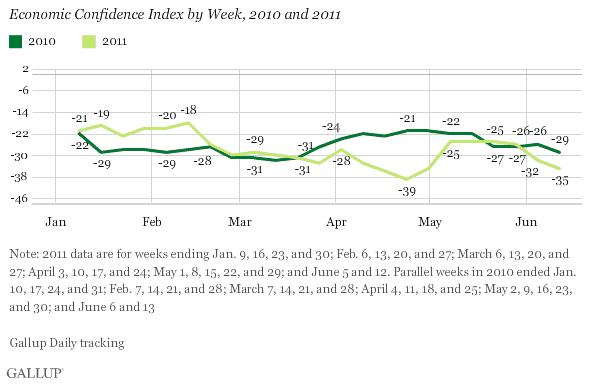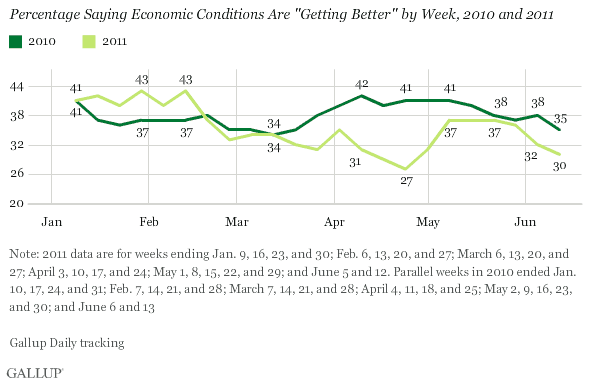PRINCETON, NJ -- A sharp deterioration in the jobs outlook and six straight weeks of Wall Street declines sent Americans' confidence in the U.S. economy plunging to an average of -35 during the week ending June 12 -- a decline of nine percentage points from two weeks ago, and six points worse than it was in the same week a year ago. Economic confidence is now approaching a 2011 weekly low.

Economic confidence reached its peak so far this year at -18 in February and then generally declined through the week ending April 24, when it reached -39 as gas prices surged and economic activity slowed. Economic confidence improved to -25 during the week after Osama bin Laden's death and coincident with the "rally effect" in President Obama's approval rating. However, Americans have become more pessimistic about the economy in early June, with confidence reverting to late April levels.
Gallup's Economic Confidence Index consists of two items: one measuring Americans' views about whether the U.S. economy is "getting better" or "getting worse" and the second measuring Americans' ratings of current economic conditions as "excellent," "good," "only fair," or "poor." The early June plunge in weekly economic confidence is attributable to declines in both items.
Economic Expectations Worsening
Thirty percent of Americans said the U.S. economy is getting better last week -- down from 37% during most of May and near the low for the year. This is five points below the reading for the same week in 2010.

"Poor" Ratings of Economy Match 2011 Low Point
Nearly half of Americans rated current economic conditions as poor last week -- matching the highest level for "poor" ratings so far in 2011. These ratings are three points worse than the previous week and three points lower than a year ago.

Implications
Gallup's Economic Confidence measure surged in early May, coincident with the bump in presidential approval after the death of bin Laden. However, the bin Laden "halo effect" on economic confidence has dissipated in early June, as economic news has become increasingly negative.
Unemployment and underemployment as measured by Gallup have shown no improvement compared with a year ago. In this regard, the government's job numbers have moved closer to Gallup's numbers as the U.S. unemployment rate as reported by the BLS worsened from 8.8% in March to 9.0% in April and 9.1% in May.
The sharp drop in economic confidence in early June is consistent with the deterioration in the jobs situation, six consecutive weeks of decline on Wall Street, and fears of a global economic slowdown. Even a recent decline in gas prices to $3.78 a gallon has not been enough to offset the decline in consumer optimism -- possibly in part because overall pump prices remain more than $1 per gallon higher than they were a year ago.
The key question going forward is whether the current economic soft patch is going to be modest and transitory or something more significant. That two out of three Americans say the U.S. economy is "getting worse" -- approaching the high for the year -- suggests many consumers may see something more significant coming in terms of a summer slowdown.
Gallup.com reports results from these indexes in daily, weekly, and monthly averages and in Gallup.com stories. Complete trend data are always available to view and export in the following charts:
Daily: Employment, Economic Confidence and Job Creation, Consumer Spending
Weekly: Employment, Economic Confidence, Job Creation, Consumer Spending
Read more about Gallup's economic measures.
View our economic release schedule.
Survey Methods
Results are based on telephone interviews conducted on a weekly basis in 2011 from January to the week ending June 12 and in 2010 from January to the week ending June 13. For the week ending June 12, 2011, on the Gallup Daily tracking survey, interviews were conducted with a random sample of 3,538 adults, aged 18 and older, living in all 50 U.S. states and the District of Columbia.
For results based on the total sample of national adults, one can say with 95% confidence that the maximum margin of sampling error is ±3 percentage points.
Interviews are conducted with respondents on landline telephones and cellular phones, with interviews conducted in Spanish for respondents who are primarily Spanish-speaking. Each sample includes a minimum quota of 400 cell phone respondents and 600 landline respondents per 1,000 national adults, with additional minimum quotas among landline respondents for gender within region. Landline telephone numbers are chosen at random among listed telephone numbers. Cell phone numbers are selected using random-digit-dial methods. Landline respondents are chosen at random within each household on the basis of which member had the most recent birthday.
Samples are weighted by gender, age, race, Hispanic ethnicity, education, region, adults in the household, and phone status (cell phone only/landline only/both, cell phone mostly, and having an unlisted landline number). Demographic weighting targets are based on the March 2010 Current Population Survey figures for the aged 18 and older non-institutionalized population living in U.S. telephone households. All reported margins of sampling error include the computed design effects for weighting and sample design.
In addition to sampling error, question wording and practical difficulties in conducting surveys can introduce error or bias into the findings of public opinion polls.
For more details on Gallup's polling methodology, visit www.gallup.com.
